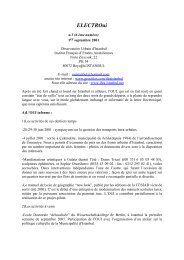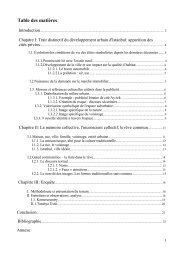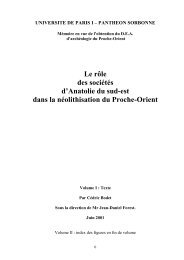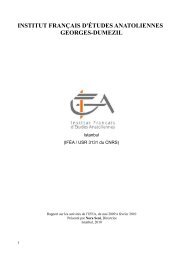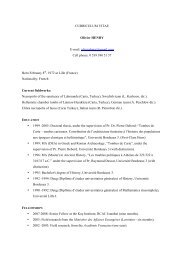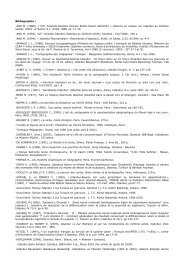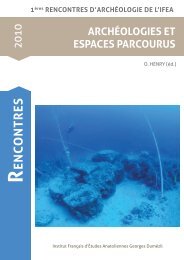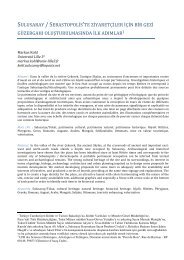You also want an ePaper? Increase the reach of your titles
YUMPU automatically turns print PDFs into web optimized ePapers that Google loves.
Colloques, appels à candidature et informations sur des instituts de recherchea) Un texte rédigé par Zafer Toprak, introduisant le lancement d’un programme de recherche surBeyoğlu et l’ouverture d’un musée de l’histoire de Beyoğlu, en collaboration avec İnsan YerleşimDerneği (Association sur l’Etablissement humain), l’Asssociation Galata, la Mairie de beyoğlu (etéventuellement l’OUI), est disponible à l’OUI. En voici un court résumé :Le sixième bureau municipal (Altinci Daire-I Belediyye), par Zafer ToprakDurant la période des Tanzimat, l’ouverture du « sixième bureau municipal » de Galata-Beyoğlu endécembre 1857 est la première véritable expérience municipale turque. Elle introduit une acceptionmoderne de la ville directement inspirée de l’Occident.Ce bureau avait, entre autres fonctions, la responsabilité de l’éclairage des rues, de l’extinction desincendies ou encore l’organisation de la carte des cadastres. Il possèdait également sa propre policemunicipale à partir de 1858, chargée en particulier d’inspecter les cafés, meyhane, théâtres, etc. Les ruesétaient divisées hiérarchiquement en 3 classes, les rues de première classe étant nettoyées plusfréquemment, tandis que dans les rues des quartiers populaires tels que Kasımpaşa ou Tarlabaşı, leramassage des ordures n’était pas assuré.Zafer Toprak annonce également les thèmes de l’exposition qu’il souhaite organiser en rapport avec cetévénement historique directement lié à l’histoire de Beyoğlu :1- La modernisation de l’Empire ottoman. L’apport des réformes Tanzimat et leurs répercussions sur leBeyoğlu de la fin du 19 ème siècle.2- La naissance du 6 ème bureau.3- Les services publics offerts par le 6 ème bureau.b) İstanbul Bilgi University Centre for Migration ResearchThe İstanbul Bilgi University Centre for Migration Research (CMR) aiming at multidisciplinary andmultilateral scientific research, launched in 2002, is the first migration research centre in Turkey.Historically Turkey has been affected by, and produced, diverse forms of migratory movementsand refugee flows. The social, economic, demographic and human rights aspects of emerging trends inmigration from, to and through Turkey present ever-increasing challenges both for social scientists andpolicy makers.The massive rural to urban population movements that started in the 1950s continued on an increasingscale to this day. External migratory movements that started during the 1960s as labour migrationtowards Western Europe, later accompanied by migration through family reunification, were followedby temporary contract migration to the Gulf States, and more recently by various forms of businessmigration towards Eastern European and Central Asian countries.Furhermore, since the early 1990s, unexpected new in-flows of migration have emerged. In addition tothe increasing number of foreign residents, these new population movements include temporary circularmigration, transit migratory flows, movements of refugees, asylum seekers and diverse forms ofirregular migration. As a result, Turkey’s position in the international migration scene has changed.Turkey has now become both a country of emigration and immigration.Against this background, the mission of the Bilgi Centre for Migration Research is to strengtheninstitutional co-ordination among researchers through several networking activities, to support newresearch and joint projects, and to produce reliable information based on research findings that cancontribute to realistic policy and decision making processes.The Centre for Migration Research aims to:• promote multidisciplinary and interdisciplinary research on diverse aspects of the causes,dynamics and conseq uences of internal and international migration;43




